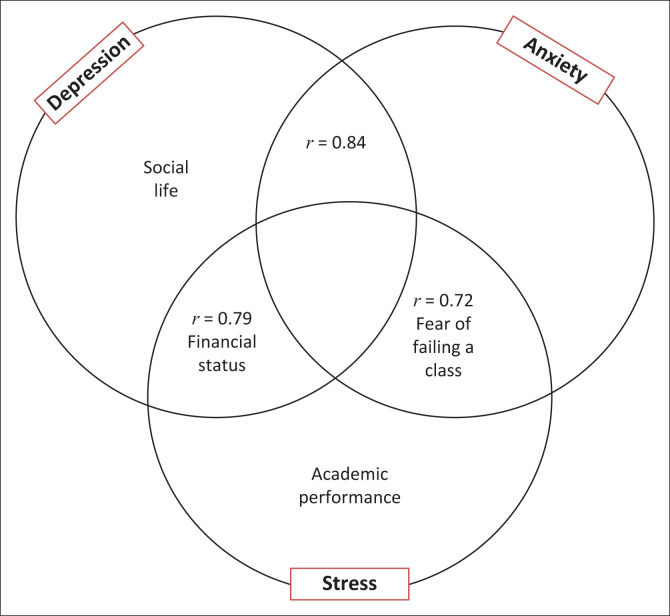Prevalence of psychological symptoms and their correlates among physiotherapy clinical students: A cross-sectional study.
IF 1.2
Q4 REHABILITATION
引用次数: 2
Abstract
Background Mental health in medical students is well researched, with physiotherapy students receiving less attention even though psychiatry is a recognised specialty within physiotherapy. Objectives To assess the prevalence and correlates of depression, anxiety and stress among physiotherapy clinical students. Methods A descriptive cross-sectional study design was employed on 402 physiotherapy clinical students aged 17–40 years using a convenience sampling method. The data were collected using the self-administered 42-items Depression, Anxiety and Stress scale (DASS) and the data were analysed using a Chi-square test and binary logistic regression analysis. Results The prevalence of depression, anxiety and stress among these students was 79.9%, 85.6% and 81.6%, respectively. The results indicate that financial status and social life influenced depression by 20.6% (odds ratio [OR] [95%] = 1.206 [1.110, 1.311]) and 36% (OR [95%] = 1.360 [1.050, 1.764]), respectively. Fear of repeating a class influenced anxiety by eight times (OR [95%] = 8.330 [6.643, 10.422]). Fear of repeating a class, financial status and academic performance influenced stress by eight times (OR [95%] = 8.360 [6.677, 10.470]), 17.5% (OR [95%] = 1.175 [1.083, 1.275]) and 18.1% (OR [95%] = 1.181 [1.083, 1.276]), respectively. Conclusion Our study concluded that there was a high prevalence of depression, anxiety and stress among physiotherapy clinical students. These outcomes suggest that more attention needs to be given to improving physiotherapy clinical students’ mental health, which will ultimately improve learning outcomes. Clinical implications The long-term effects of psychological distress could potentially impact students’ academic performance. It may also have long-lasting effects after graduation. Therefore, students who are at risk of developing psychological symptoms are needed to be thoroughly examined and then receive early required interventions.

物理治疗临床学生心理症状的患病率及其相关性:一项横断面研究。
背景:医学生的心理健康得到了很好的研究,而物理治疗的学生得到的关注较少,尽管精神病学是物理治疗中公认的专业。目的:了解物理治疗专业临床学生抑郁、焦虑和压力的患病率及其相关因素。方法:采用描述性横断面研究设计,采用方便抽样法对402名17 ~ 40岁的物理治疗临床学生进行调查。采用自填抑郁、焦虑和压力量表(DASS)收集42项数据,采用卡方检验和二元logistic回归分析。结果:大学生抑郁、焦虑和压力的患病率分别为79.9%、85.6%和81.6%。结果表明,经济状况和社会生活对抑郁症的影响分别为20.6%(比值比[OR][95%] = 1.206[1.110, 1.311])和36% (OR[95%] = 1.360[1.050, 1.764])。对重复上课的恐惧影响了8倍的焦虑(OR[95%] = 8.330[6.643, 10.422])。害怕重复上课、经济状况和学习成绩对压力的影响分别为8倍(OR[95%] = 8.360[6.677, 10.470])、17.5% (OR[95%] = 1.175[1.083, 1.275])和18.1% (OR[95%] = 1.181[1.083, 1.276])。结论:临床物理治疗专业学生抑郁、焦虑和压力的发生率较高。这些结果表明,需要更多地关注改善物理治疗临床学生的心理健康,从而最终提高学习效果。临床意义:心理困扰的长期影响可能会影响学生的学习成绩。它还可能在毕业后产生持久的影响。因此,有可能出现心理症状的学生需要进行彻底检查,然后接受必要的早期干预。
本文章由计算机程序翻译,如有差异,请以英文原文为准。
求助全文
约1分钟内获得全文
求助全文
来源期刊

South African Journal of Physiotherapy
REHABILITATION-
CiteScore
1.70
自引率
9.10%
发文量
35
审稿时长
30 weeks
 求助内容:
求助内容: 应助结果提醒方式:
应助结果提醒方式:


